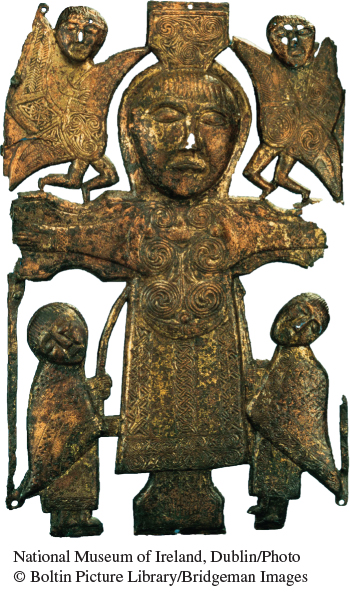Missionaries’ Actions
207
During the Roman occupation, small Christian communities were scattered throughout Gaul and Britain. The leaders of some of these, such as Bishop Martin of Tours (ca. 316–397), who founded a monastery and established a rudimentary parish system in his diocese, supported Nicene Christianity (see “The Acceptance of Christianity”). Other missionaries were Arian Christians, who also founded dioceses and converted many barbarian groups. Bishop Ulfilas (ca. 310–383), for example, an Ostrogoth himself, translated the Bible from the Greek in which it was normally written into the Gothic language, creating a new Gothic script in order to write it down. The Ostrogoths, Visigoths, Lombards, and Vandals were all originally Arian Christians, though over the sixth and seventh centuries most of them converted to Roman Christianity, sometimes peacefully and sometimes as a result of conquest.

Tradition identifies the conversion of Ireland with Saint Patrick (ca. 385–461). Born in England to a Christian family of Roman citizenship, Patrick was captured and enslaved by Irish raiders and taken to Ireland, where he worked as a herdsman for six years. He escaped and returned to England, where a vision urged him to Christianize Ireland. In preparation, Patrick studied in Gaul and was consecrated a bishop in 432. He returned to Ireland, where he converted the Irish tribe by tribe, first baptizing the chief of each tribe. By the time of Patrick’s death, the majority of the Irish people had received Christian baptism.
In his missionary work, Patrick had the strong support of Bridget of Kildare (ca. 450–528), daughter of a wealthy chieftain. Bridget defied parental pressure to marry and became a nun. She and the other nuns at Kildare instructed relatives and friends in basic Christian doctrine, made religious vestments (clothing) for churches, copied books, taught children, and above all set a religious example by their lives of prayer. In this way, in Ireland and later in continental Europe, women like the nuns at Kildare shared in the process of conversion.
208
The Christianization of the English began in earnest in 597, when Pope Gregory I sent a delegation of monks under the Roman Augustine to Britain. Augustine’s approach, like Patrick’s, was to concentrate on converting those who held power. When he succeeded in converting Ethelbert, king of Kent, the baptism of Ethelbert’s people took place as a matter of course. Augustine established his headquarters, or see, at Canterbury, the capital of Kent in southern England.
In the course of the seventh century, two Christian forces competed for the conversion of the pagan Anglo-